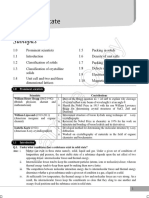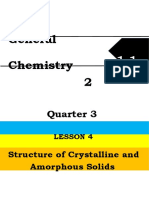Us To Make Solids of Desired Purpose
Us To Make Solids of Desired Purpose
Uploaded by
Sam JonesCopyright:
Available Formats
Us To Make Solids of Desired Purpose
Us To Make Solids of Desired Purpose
Uploaded by
Sam JonesOriginal Title
Copyright
Available Formats
Share this document
Did you find this document useful?
Is this content inappropriate?
Copyright:
Available Formats
Us To Make Solids of Desired Purpose
Us To Make Solids of Desired Purpose
Uploaded by
Sam JonesCopyright:
Available Formats
SOLIDS From earlier data we know that everything is made up matter and mater is further divided into three
categories: 1. Solid 2. Liquid 3. Gas
All these three types of matter are essential for us, but comparatively we use solids more often than liquids or gases. Thus Solids form up the most of the matter that we use and rely upon. Solids with different properties arise due to the different arrangement of atoms in the structure and are thus used for different purposes. The study here is concerned with structure of solids, structure makes a huge different in the chemistry of the properties of the substance. More precisely, the properties of a substance i.e. solids, depend upon the nature of constituent particles and the binding forces between them. The correlation between the structure and properties of solids helps us to make solids of desired purpose. Gases and liquids are called Fluids, because they have an ability to flow as, their constituent particles are free to move but in solids these constituent particles have fixed positions and they can only oscillate about their mean position (mean position just refers to the position of object at rest). As they have fixed position this explains their rigidity. The structure, arrangement, imperfections and constituent particles is what defines a solids properties. The intermolecular forces in between the atoms of solids tends to keep the atoms in contact and bonded to each other and the thermal energy that is the heat tends to keep them apart by making them move faster. Thus, at low temperatures the thermal energy is low and the bonding energy high but as the temperature increase the thermal energy overcomes the bonding energy and breaks their bonds. Some definite properties of solids are: 1. They have definite, volume and space. 2. They have strong intermolecular forces. 3. They have short intermolecular distances. 4. They are incompressible and rigid. 5. The constituent particles are having fixed positions and can only oscillate about their mean point. On the basis of arrangement of particles solids can be classified as: Amorphous and Crystalline. Crystalline solids: These are made up of a large number of small crystals; each crystal has a definite shape and characteristic. In a crystal all the atoms, or ions or molecules are arranged in a repeating order. There is a regular pattern which repeats itself over the entire crystal; to have such an arrangement is also called long range order. Examples of crystalline solids are: Diamonds, Rock Salt (NaCl), Graphite etc. because they have a definite arrangement of particles.
Structure of diamond
Structure of NaCl
Structure of graphite
Amorphous Solids: Amorph means no form, thus amorphous solids are those which have irregular arrangement. They do not have any crystals and their constituent particles are arranged in a short range order i.e. they dont repeat their pattern over the whole solid. Examples could be glass, wax etc. As these two solids are having different arrangement of particles thus they exhibit or show different properties. Crystalline solids have a sharp melting point, whereas amorphous solids could be soften over a range of temperature and moulded into various shapes. Amorphous solids have a tendency to flow like liquids but they flow really slowly. Thus they are also referred to as Pseudo solids or super cooled liquids. Also, Crystalline solids are anisotropic, anisotropic means the tendency to show different physical properties in different directions, when measured in directions crystalline solids show different values for physical properties unlike Amorphous solids which show same properties in all directions and are thus called isotropic because they have disordered pattern of arrangement everywhere but crystalline solids have a fixed pattern and when viewed from different angles, a new pattern is observed. Differences between crystalline solids and amorphous solids:
Crystalline Solids 1. Sharp melting point 2. Anisotropic in nature 3. True solids 4. Long range order arrangement of particles 5. When cut, they split into smooth surface pieces 6. E.g. Diamond, quartz, NaCl, graphite etc.
Amorphous solids 1. Gradually soften over a range of temperature 2. Isotropic in nature 3. Pseudo solids or super cooled liquids 4. Short range order arrangement of particles 5. When cut, they split into irregular surface pieces 6. E.g. wax, quartz glass, plastics etc.
Amorphous silicon is the best photovoltaic material used for conversion of sunlight into electricity.
CLASSIFICATION OF CRYSTALLINE SOLIDS The most abundant solids are crystalline solids. Most of the solids substances are crystalline in nature like iron, copper, silver, iodine, naphthalene etc. On the basis of nature of intermolecular forces, crystalline solids are further divided into four types: 1. Molecular solids 2. Ionic solids 3. Metallic solids 4. Covalent solids 1. Molecular solids: These solids have molecules as their constituent particles. They are further divided into three types. a. Non-polar molecular solids b. Polar molecular solids c. Hydrogen-bonded molecular solids. a. Non polar molecular solids: These solids have same atoms bonded to each other, and these have non polar covalent bonds and their atoms are held to each other by weak dispersion forces or London forces. These solids are soft and non-conductors of electricity. They have low melting points and are usually liquids or gases at room temperature and pressure. E.g. oxygen (O2), nitrogen (N2), chlorine (Cl2), iodine (I2) etc. b. Polar molecular solids: These solids have different atoms held together by polar covalent bonds and the molecules in such solids are held by relatively strong dipole-dipole interactions. These are also soft and non-conductors of electricity, but their melting point are comparatively high to those of non-polar molecular solids. E.g. HCl, solid NH3 etc. c. Hydrogen-bonded molecular solids: These solids contain molecules which have hydrogen bonded to nitrogen, fluorine or oxygen. Hydrogen bonding is relatively strong. They are non-conductors and soft liquids during room temperature. E.g. Hydrogen (H2O) etc. 2. Ionic solids: Ions are the constituent particles of ionic solids. They have cations and anions which have strong columbic force of attraction. Since the ions are not free to move about they are electrical insulators but due to strong forces of attraction they are hard and have high melting points. However in molten state they conduct electricity. E.g. NaCl etc. 3. Metallic solids: These are usually the metals; these have a sea of mobile electrons which are spread evenly in the crystal, they are held together as there is attraction between free electrons and the donor metal atoms. As they have free electrons they are conductors of electricity. They are highly malleable and ductile. E.g. Fe, Ag etc. 4. Covalent solids: These are also called network solids. These have atoms bonded to each other by sharing of electrons and just have strong covalent bonds. And they dont have free electrons and thus are insulators, but due to their strong bonds they have high melting points and are very hard and brittle. Except Graphite which is soft and a conductor.
Crystalline solids have a regular and repeating arrangement of constituent particles, thus to represent them diagrammatically in three dimensions in which each particle is represented as a point and the structure formed is called a crystal lattice. There are 14 different types of crystal lattices also known as Bravais lattices.
You might also like
- Filtration Questions)Document8 pagesFiltration Questions)Evan CarniyanNo ratings yet
- Structure and Properties of Solids Helps Us To Make Solids of Desired PurposeDocument37 pagesStructure and Properties of Solids Helps Us To Make Solids of Desired PurposeSam JonesNo ratings yet
- CHAPTER-solid State Part 1Document2 pagesCHAPTER-solid State Part 1Arpandeep KaurNo ratings yet
- Solid StateDocument11 pagesSolid StateGomathi VarshiniNo ratings yet
- Solid:-A Solid Is Defined As The Substances Which Possess Rigidity Have ADocument2 pagesSolid:-A Solid Is Defined As The Substances Which Possess Rigidity Have ASaatwat CoolNo ratings yet
- Amorphous and Crystalline SolidsDocument8 pagesAmorphous and Crystalline SolidsAli ImranNo ratings yet
- 1 Solid State 25Document25 pages1 Solid State 25Aryan POONIANo ratings yet
- Types of Solid: Physical and Chemical Properties of SolidsDocument10 pagesTypes of Solid: Physical and Chemical Properties of SolidsDoD GamingNo ratings yet
- CH-1 (Xii)Document11 pagesCH-1 (Xii)Vijay KumarNo ratings yet
- UNIT - II InorganicDocument28 pagesUNIT - II Inorganicharirajans71No ratings yet
- LP - GP - Coulomb's LawDocument9 pagesLP - GP - Coulomb's LawAllyza SobosoboNo ratings yet
- Chapter 3Document9 pagesChapter 3JeromeNo ratings yet
- Presentation 5Document25 pagesPresentation 5mitchieeebabaran30No ratings yet
- Solid StateDocument49 pagesSolid Statekishangopi123No ratings yet
- LP - GC - Nature of SolidsDocument9 pagesLP - GC - Nature of SolidsAllyza SobosoboNo ratings yet
- WEEK 4 SS 1 Physics NoteDocument3 pagesWEEK 4 SS 1 Physics NoteoluwafadekemifashinaNo ratings yet
- Types of SolidDocument37 pagesTypes of Solidmjlngpogi.walangibaNo ratings yet
- Solid StateDocument17 pagesSolid Statenoorunnisa0184No ratings yet
- CBSE Class 12 Chemistry Chapter 1 The Solid State Revision NotesDocument69 pagesCBSE Class 12 Chemistry Chapter 1 The Solid State Revision Notesnitish872shuklaNo ratings yet
- Rizal General Chemistry 2 q3 Slm4Document12 pagesRizal General Chemistry 2 q3 Slm4Darlene OpeñaNo ratings yet
- Unit III CrystollographyDocument56 pagesUnit III Crystollographymwita mwitaNo ratings yet
- Genchem2 q3m2b Solids-And-imf FinalDocument50 pagesGenchem2 q3m2b Solids-And-imf Finalroxtonandrada8No ratings yet
- 12th Science HSC Chemistry I PDFDocument14 pages12th Science HSC Chemistry I PDFSayyed SohelNo ratings yet
- General Chemistry 2 - Q3 - SLM4Document11 pagesGeneral Chemistry 2 - Q3 - SLM4Jonnel RoqueNo ratings yet
- Intermolecular Forces of Liquids and Solids Solids and Their PropertiesDocument39 pagesIntermolecular Forces of Liquids and Solids Solids and Their PropertiesSTANNo ratings yet
- General Chemistry 2 Q3 Week 2Document2 pagesGeneral Chemistry 2 Q3 Week 2jcjimz259No ratings yet
- Crystalline Solids: 4. Clean Cleavage With KnifeDocument5 pagesCrystalline Solids: 4. Clean Cleavage With KnifeShin Se KyungNo ratings yet
- Intermolecular Forces of Liquids and Solids Solids and Their Properties PDFDocument13 pagesIntermolecular Forces of Liquids and Solids Solids and Their Properties PDFpieNo ratings yet
- The Solid State: Crystalline SolidsDocument3 pagesThe Solid State: Crystalline Solidsmillinagi95No ratings yet
- The Structure of Crystalline andDocument18 pagesThe Structure of Crystalline andBosston PangetNo ratings yet
- Chemistry NotesDocument208 pagesChemistry Notespushyanthreddy3No ratings yet
- Solid StateDocument25 pagesSolid StateDigvijay SolankiNo ratings yet
- 5921apni KakshaDocument109 pages5921apni KakshaVimal PrasadNo ratings yet
- Properties of SolidsDocument3 pagesProperties of SolidsJashmin LarozaNo ratings yet
- Classifying MatterDocument53 pagesClassifying MatterTanya MaheshwariNo ratings yet
- SheetDocument108 pagesSheetPinkyNo ratings yet
- Local Media8298476867722663082 PDFDocument34 pagesLocal Media8298476867722663082 PDFRaquel AvilaNo ratings yet
- Lakshya JEE AIR (2025) : Solid StateDocument67 pagesLakshya JEE AIR (2025) : Solid Stateb63672304No ratings yet
- Phy 314 - 231101 - 132641Document27 pagesPhy 314 - 231101 - 132641samuelagbomolaNo ratings yet
- Mrs. AP Types of Solids 2Document43 pagesMrs. AP Types of Solids 2jedidiahkian77No ratings yet
- Intermolecular ForcesDocument9 pagesIntermolecular Forces11-STEM 1 Penaso, Hannah Nicole V.No ratings yet
- The Solid StateDocument2 pagesThe Solid StateDisha SarangalNo ratings yet
- Module 5 - Crystalline and Amorphous SolidsDocument3 pagesModule 5 - Crystalline and Amorphous Solidsmm.vince21100% (1)
- What Is The Particle Theory of MatterDocument5 pagesWhat Is The Particle Theory of MatterKaren OrlanskiNo ratings yet
- Characteristics of MatterDocument3 pagesCharacteristics of MatterParimala DhanasekaranNo ratings yet
- Aerospce Batch 3 PHY 4201 Lecture 1Document26 pagesAerospce Batch 3 PHY 4201 Lecture 1Rasel khanNo ratings yet
- Intermolecular Forces of Liquids and Solids Solids and Their PropertiesDocument59 pagesIntermolecular Forces of Liquids and Solids Solids and Their PropertiesAndre Jose ErminoNo ratings yet
- Conductive Crystalline Solids 3333Document6 pagesConductive Crystalline Solids 3333great007g7No ratings yet
- Types and Properties of SolidsDocument38 pagesTypes and Properties of SolidsangelesjheancasseyNo ratings yet
- Chemistry Grade 9Document56 pagesChemistry Grade 9Dr Wafa SheikhNo ratings yet
- Components of MatterDocument19 pagesComponents of MatterJerry PrestoNo ratings yet
- ES Module 3 - Quarter 1 - Types of SolidsDocument13 pagesES Module 3 - Quarter 1 - Types of SolidsAnalynAsuncionAtaydeNo ratings yet
- Noo Xii Ch01 Solid StateDocument51 pagesNoo Xii Ch01 Solid StateG boiNo ratings yet
- Defining RockDocument24 pagesDefining Rockgeneabi012No ratings yet
- Chem ReviewerDocument3 pagesChem Reviewernashnitsuga20No ratings yet
- Science Reviewer Q3Document12 pagesScience Reviewer Q3Ayessah Ingrid AbeloNo ratings yet
- Lesson 3 Intermolecular Forces of Liquids and Solids - Solids and TheirDocument24 pagesLesson 3 Intermolecular Forces of Liquids and Solids - Solids and TheirLyndy PantaoNo ratings yet
- General Chemistry 2 - LAS 2 LEARNING CAPSULEDocument5 pagesGeneral Chemistry 2 - LAS 2 LEARNING CAPSULEMark RazNo ratings yet
- Solid: What Are The Properties of A Solid?Document4 pagesSolid: What Are The Properties of A Solid?clarissaclementiaNo ratings yet
- Children Encyclopedia Chemistry: The World of KnowledgeFrom EverandChildren Encyclopedia Chemistry: The World of KnowledgeRating: 5 out of 5 stars5/5 (3)
- GCSE Chemistry Revision: Cheeky Revision ShortcutsFrom EverandGCSE Chemistry Revision: Cheeky Revision ShortcutsRating: 4.5 out of 5 stars4.5/5 (3)
- Geotechnical Failure Investigation of A Reinforced Soil Wall and Remedial Work DesignDocument11 pagesGeotechnical Failure Investigation of A Reinforced Soil Wall and Remedial Work DesignRenugopalNo ratings yet
- Alloy 6moDocument2 pagesAlloy 6moAndre SodaNo ratings yet
- CFP Apace 2024 V2Document1 pageCFP Apace 2024 V2Sai LyanaNo ratings yet
- Katalog Mitsubishi SRLD-K100Document12 pagesKatalog Mitsubishi SRLD-K100singgihNo ratings yet
- Bom 91DM43X7100Document78 pagesBom 91DM43X7100Gustavo ValenzuelaNo ratings yet
- Performance Calculator: CGP 4mm/ar 16mm/CGP 4mmDocument8 pagesPerformance Calculator: CGP 4mm/ar 16mm/CGP 4mmNikola PetrovicNo ratings yet
- Chemical Composition, Mechanical, Physical and Environmental Properties of Q235Document6 pagesChemical Composition, Mechanical, Physical and Environmental Properties of Q235Wellington AnaluisaNo ratings yet
- Performance of Contiguous Pile Wall With Raking Strut For Basement Construction of BITEC Phase 2 ProjectDocument4 pagesPerformance of Contiguous Pile Wall With Raking Strut For Basement Construction of BITEC Phase 2 ProjectSuraparb KeawsawasvongNo ratings yet
- ThermochemistryDocument57 pagesThermochemistryAlexandreau del Fierro100% (2)
- Diamond Like Carbon DLCDocument5 pagesDiamond Like Carbon DLCjbertralNo ratings yet
- Problem 130Document6 pagesProblem 130Karl Angelo CuellarNo ratings yet
- Experimental Correlation of Pool Boiling Heat Transfer For HFC134a On Enhanced Tubes Turbo EDocument8 pagesExperimental Correlation of Pool Boiling Heat Transfer For HFC134a On Enhanced Tubes Turbo EHany Elsawy AbdelrahmanNo ratings yet
- ACS 04 To FBW Manual (Reprint April 2022)Document13 pagesACS 04 To FBW Manual (Reprint April 2022)ewsbiwrNo ratings yet
- DC Generator: NMJ31103 Electrical Machines and DrivesDocument77 pagesDC Generator: NMJ31103 Electrical Machines and DrivesHui QingNo ratings yet
- Chemistry Tutorvista Com Inorganic Chemistry Metallurgy HTMLDocument18 pagesChemistry Tutorvista Com Inorganic Chemistry Metallurgy HTMLSaid MajiNo ratings yet
- C. Molecular Forces or Thermal Behavior: FibersDocument14 pagesC. Molecular Forces or Thermal Behavior: FibersKuldeep singh ChandelNo ratings yet
- En 1992-2 Checks - InfoGraph Software Für Die TragwerksplanungDocument6 pagesEn 1992-2 Checks - InfoGraph Software Für Die Tragwerksplanungnepoznati1111No ratings yet
- Peek High Performance Thermoplastics Material For Gear, Bushing, Washer, Valve, EtcDocument3 pagesPeek High Performance Thermoplastics Material For Gear, Bushing, Washer, Valve, EtchudileksonoNo ratings yet
- Fabio C. Poderoso, Jeferson J. Arenzon and Yan Levin - New Ordered Phases in A Class of Generalized XY ModelsDocument4 pagesFabio C. Poderoso, Jeferson J. Arenzon and Yan Levin - New Ordered Phases in A Class of Generalized XY ModelsYidel4313No ratings yet
- Copeland Refrigeration ManualDocument44 pagesCopeland Refrigeration ManualArmando ChilinNo ratings yet
- 1-Mechanics of Material - I (Mid Term)Document134 pages1-Mechanics of Material - I (Mid Term)irum,100% (1)
- Plastic Spur Gear Pair FailureDocument14 pagesPlastic Spur Gear Pair FailureDan Wolf100% (1)
- ASTM - E21-17e1 - Standard Test Methods For Elevated Temperature Tension Tests of Metallic MaterialsDocument8 pagesASTM - E21-17e1 - Standard Test Methods For Elevated Temperature Tension Tests of Metallic MaterialsuristerinNo ratings yet
- Thermodynamics (TKJ3302) Lecture Notes - 3 Properties of Pure SubstancesDocument34 pagesThermodynamics (TKJ3302) Lecture Notes - 3 Properties of Pure Substancesmamat8889% (9)
- Disposable Diaper IndustryDocument3 pagesDisposable Diaper IndustryAbu Alayna100% (1)
- Physics Now de Jon OgbornDocument159 pagesPhysics Now de Jon OgbornFrancisco GurrolaNo ratings yet
- Von Mises Yield CriterionDocument4 pagesVon Mises Yield CriterionJanatan ChoiNo ratings yet
- 202005121235123360asheesh-NEWTON RINGDocument4 pages202005121235123360asheesh-NEWTON RINGRakNo ratings yet
- Electrons and ''Holes'' - S.Document5 pagesElectrons and ''Holes'' - S.Manikandan SundararajNo ratings yet

























































































